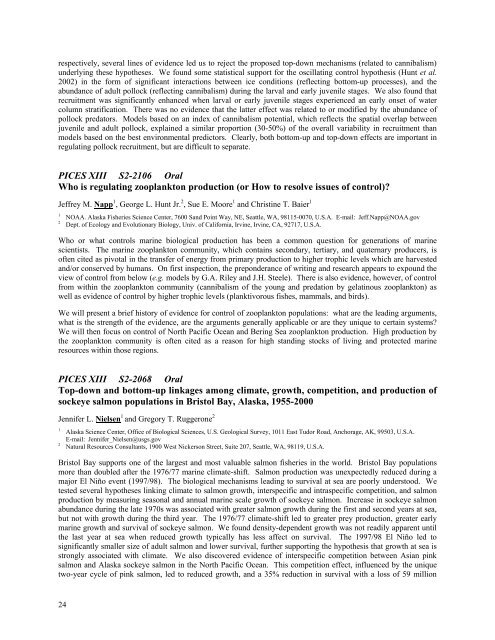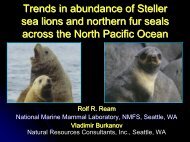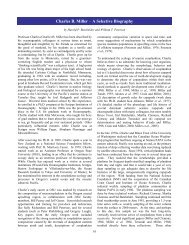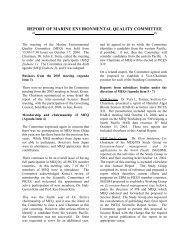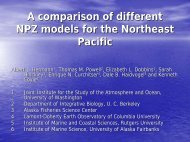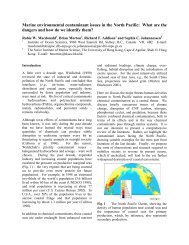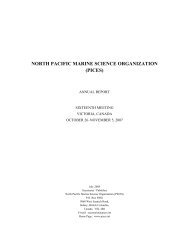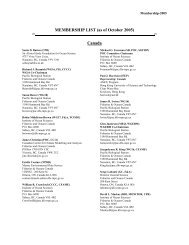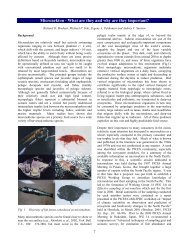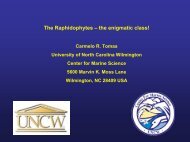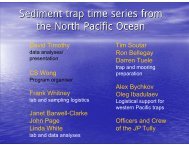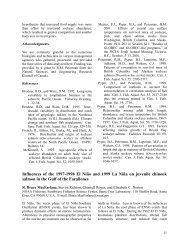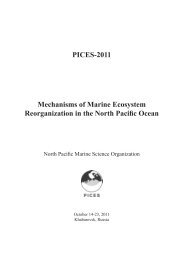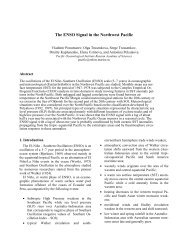Full Book - PICES
Full Book - PICES
Full Book - PICES
- No tags were found...
Create successful ePaper yourself
Turn your PDF publications into a flip-book with our unique Google optimized e-Paper software.
espectively, several lines of evidence led us to reject the proposed top-down mechanisms (related to cannibalism)underlying these hypotheses. We found some statistical support for the oscillating control hypothesis (Hunt et al.2002) in the form of significant interactions between ice conditions (reflecting bottom-up processes), and theabundance of adult pollock (reflecting cannibalism) during the larval and early juvenile stages. We also found thatrecruitment was significantly enhanced when larval or early juvenile stages experienced an early onset of watercolumn stratification. There was no evidence that the latter effect was related to or modified by the abundance ofpollock predators. Models based on an index of cannibalism potential, which reflects the spatial overlap betweenjuvenile and adult pollock, explained a similar proportion (30-50%) of the overall variability in recruitment thanmodels based on the best environmental predictors. Clearly, both bottom-up and top-down effects are important inregulating pollock recruitment, but are difficult to separate.<strong>PICES</strong> XIII S2-2106 OralWho is regulating zooplankton production (or How to resolve issues of control)?Jeffrey M. Napp 1 , George L. Hunt Jr. 2 , Sue E. Moore 1 and Christine T. Baier 112NOAA. Alaska Fisheries Science Center, 7600 Sand Point Way, NE, Seattle, WA, 98115-0070, U.S.A. E-mail: Jeff.Napp@NOAA.govDept. of Ecology and Evolutionary Biology, Univ. of California, Irvine, Irvine, CA, 92717, U.S.A.Who or what controls marine biological production has been a common question for generations of marinescientists. The marine zooplankton community, which contains secondary, tertiary, and quaternary producers, isoften cited as pivotal in the transfer of energy from primary production to higher trophic levels which are harvestedand/or conserved by humans. On first inspection, the preponderance of writing and research appears to expound theview of control from below (e.g. models by G.A. Riley and J.H. Steele). There is also evidence, however, of controlfrom within the zooplankton community (cannibalism of the young and predation by gelatinous zooplankton) aswell as evidence of control by higher trophic levels (planktivorous fishes, mammals, and birds).We will present a brief history of evidence for control of zooplankton populations: what are the leading arguments,what is the strength of the evidence, are the arguments generally applicable or are they unique to certain systems?We will then focus on control of North Pacific Ocean and Bering Sea zooplankton production. High production bythe zooplankton community is often cited as a reason for high standing stocks of living and protected marineresources within those regions.<strong>PICES</strong> XIII S2-2068 OralTop-down and bottom-up linkages among climate, growth, competition, and production ofsockeye salmon populations in Bristol Bay, Alaska, 1955-2000Jennifer L. Nielsen 1 and Gregory T. Ruggerone 212Alaska Science Center, Office of Biological Sciences, U.S. Geological Survey, 1011 East Tudor Road, Anchorage, AK, 99503, U.S.A.E-mail: Jennifer_Nielsen@usgs.govNatural Resources Consultants, 1900 West Nickerson Street, Suite 207, Seattle, WA, 98119, U.S.A.Bristol Bay supports one of the largest and most valuable salmon fisheries in the world. Bristol Bay populationsmore than doubled after the 1976/77 marine climate-shift. Salmon production was unexpectedly reduced during amajor El Niño event (1997/98). The biological mechanisms leading to survival at sea are poorly understood. Wetested several hypotheses linking climate to salmon growth, interspecific and intraspecific competition, and salmonproduction by measuring seasonal and annual marine scale growth of sockeye salmon. Increase in sockeye salmonabundance during the late 1970s was associated with greater salmon growth during the first and second years at sea,but not with growth during the third year. The 1976/77 climate-shift led to greater prey production, greater earlymarine growth and survival of sockeye salmon. We found density-dependent growth was not readily apparent untilthe last year at sea when reduced growth typically has less affect on survival. The 1997/98 El Niño led tosignificantly smaller size of adult salmon and lower survival, further supporting the hypothesis that growth at sea isstrongly associated with climate. We also discovered evidence of interspecific competition between Asian pinksalmon and Alaska sockeye salmon in the North Pacific Ocean. This competition effect, influenced by the uniquetwo-year cycle of pink salmon, led to reduced growth, and a 35% reduction in survival with a loss of 59 million24


